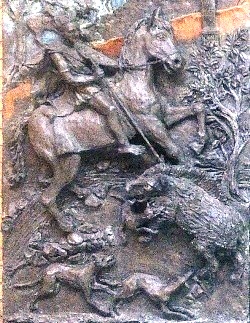 |
King Arthur and the Twrch TrwythCwmamman or "Amanwy" forms part of the ancient legend of Culhwch and Olwen, found in the Red Book of Hergest which is believed to have been written some time between 1375 and 1425. A fragmented version of the legend is also found in the White book of Rhydderch, which stems back to the mid 14th Century. Culhwch and Olwen is considered to be the oldest Arthurian romance and although a work of fiction (die hard King Arthur fans may resent that remark) the reference to Amanwy in this ancient work of prose, firmly embeds the Amman Valley in the magical world of King Arthur. The complex story is a tale of good and evil, love and challenge,
the quest for adventure, sometimes grotesquely violent but symbolic
and magical throughout. |
|
Culhwch, although the son of a king, was born in a pig enclosure after his expectant mother went into labour after becoming frightened by some pigs. He was thereafter raised in secret by the swineherd who was taking care of the animals. Following the death of Culhwch's mother, his father Cilydd Wledig marries another king's widow who later plans to marry off her own daughter to Culhwch, who refuses. The angry queen puts a curse on Culhwch, so that he can marry no-one but Olwen, who was the daughter of the cruel giant king named Ysbaddaden Pencawr. Although he has never witnessed Olwen's beauty, Culhwch becomes infatuated with her and seeks help from his famous cousin, King Arthur whose court was in Cornwall. Arthur's scouts search for Olwen to no avail and after a year, Cei (Sir Kay) suggests to Culhwch that they go on the quest themselves. Arthur selects six of his finest warriors including those whose names might be associated in later Arthurian legends as Sir Kay, Sir Bedivere and Sir Gawain. Another of the six who was named Menw is able to magically transform into the shape of a bird. During the search, Culhwch finds his aunt who is visited by Olwen every Saturday. On seeing Olwen's beauty, Culhwch's infatuation with her turns to love. Alas, her father Ysbaddaden Pencawr is under a curse himself and will die should Olwen marry. Culhwch and Arthur's warriors were given many challenging tasks by Olwen's father, which must be completed before Olwen is allowed to marry, including killing the Twrch Trwyth, an Irish king whom God had turned into a wild boar for his wickedness. The Twrch Trwyth is accompanied by seven young pigs, men who had also been turned. Between the ears of the Twrch trwyth were shears, a comb and a razor. The ferocious beast itself was adorned with toxic bristles. After several adventures in which they obtain a special sword, a hound and a boars tusk, all of which are necessary to kill the Twrch Trwyth, the band of seven questers journeyed to Ireland, a third of which had been laid waste by the beast. King Arthur, along with an army accompanied them. Repelling Arthurs force, the Twrch Trwyth crossed the Irish Sea and landed in Dyfed. Arthur, along with a large force of men chased the Twrch and its fellow beasts through Wales, Arthur's army suffering many casualties during the fighting. Following a fight at "Dyffryn Llychwr", the Twrch Trwyth and his small herd fled to "Mynydd Amanw" where three of the pigs were slain, two of whom were named Twrch Llawin and Gwys. Two more of the pigs, namely Banw and Benwig were killed at "Dyffryn Amanw", generally accepted to be the Amman Valley. The Twrch Trwyth and the two remaining pigs escaped the Amman Valley but while the Twrch Trwyth made it as far as the River Severn, the two smaller pigs were slain soon after. At the Severn, the Twrch Trwyth was temporarily overpowered where his razor and shears were seized by Arthur's men. The beast escaped again and made it to Cornwall, where the comb was eventually taken. The Twrch Trwyth was driven into the sea and nothing was seen of the creature ever again. The story continued in a rather bloodthirsty fashion, with the killing of a witch and the eventual torture and killing of Olwen's father, the giant-king. Before his death, he gave his permission for Culhwch to marry Olwen. Wed they did and Culhwch remained true to Olwen for the rest of his life. The legend's effect on the community is deep rooted but not widespread. Many of Cwmamman's residents are not familiar with the tale and do not realise that King Arthur himself is said to have traversed their locality on an epic adventure. On another level, there are those who celebrate the Amman Valley's part in the story, such as the Motorcycle group, who once proudly displayed the Twrch Trwyth boar's head as their emblem. Amman Valley School also has the head of the Twrch Trwyth as the school logo, while a former caretaker of the school, David Rees Griffiths proudly carried the old title "Amanwy" as his eisteddfod name. At the border of Ammanford and the village of Penybanc is a metal sculpture symbolising the Twrch Trwyth and two of his company; while in Cwmamman itself, Ysgol y Bedol school displays a splendid sculpture commemorating the community's history, including its mythology. The Twrch is depicted fighting a warrior and his dogs in what has become part of the village's treasures (see above image). Another legend depicts King Arthur himself as a Giant crossing over the Amman Valley. At the place on the Betws Mountain above Brunant Farm where he stopped to empty his shoe, there is a large flat rock, known by some as "Y Garreg Fawr" (Big Rock) and to others as "Arthurs Stone". |
|